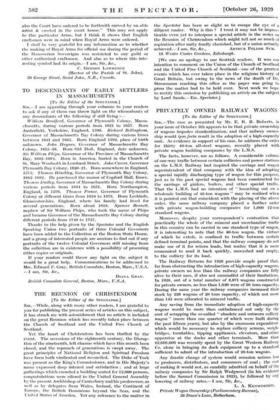PRIVATELY OWNED RAILWAY WAGONS
[To the Editor of the SPECTATOR.] SIR,—The case as presented by Mr. E. R. B. Roberts, in your issue of October 5th appears to be that private ownership of wagons impedes standardization, and that railway owner- ship would ipso facto result in the adoption of a high-capacity unit. As evidence in support of his case, he adduces the order for thirty 40-ton all-steel wagons, recently placed with private wagon building companies by the L.M.S.
The facts, however, are as follows. A considerable volume of one-way traffic between certain collieries and power stations on the L.M.S. Railway had inspired the carriage and wagon superintendent of that company with the idea of adopting a special rapidly discharging type of wagon for this purpose, just as in the past special wagons had been constructed for the carriage of girders, boilers, and other special traffic. That the L.M.S. had no intention of "launching out on a wholesale building of 40-ton wagons" may be realized when it is pointed out that coincident with the placing of the above order, the same railway company placed a further order with private wagon-building companies for 1,000 12-ton standard wagons.
Moreover, despite your correspondent's contention that practically the whole of the mineral and merchandize traffic in this country can be carried in one standard type of wagon, it is interesting to note that the 40-ton wagon, the virtues of which he extols, is confined to traffic between certain defined terminal points, and that the railway company do not make use of it for return loads, but realize that it is more economical to send it back quickly, unwashed and empty, to the colliery for its load.
The Railway Returns for 1928 provide ample proof that, far from obstructing the introduction of high-capacity wagons, private owners no less than the railway companies are fully alive to their uses, if also not unmindful of their limitations. In 1928, out of a total number of 8,671 wagons constructed for private owners, no less than 1,020 were of 20 tons capacity. During the same year the railway companies increased their stock by 226 wagons of 20 tons capacity, of which not more than 145 were allocated to mineral traffic.
Any saving from the immediate adoption of high-capacity wagons would be more than outbahinced not only by the cost of scrapping the so-called "obsolete and outworn colliery wagon" (more than one quarter of which were built during the past fifteen years), but also by the enormous expenditure which would be necessary to replace colliery screens, weigh. bridges, turntables, tipping appliances, elevators, and other apparatus at the docks and other terminals. More than 12,000,000 was recently spent by the Great Western Railway Co. alone in bringing its dock equipment up to a standard sufficient to admit of the introduction of 20-ton wagons.
Any drastic change of system would occasion serious loss to producers, distributors, and consumers of coal ; the cost of maldng it would not, as candidly admitted on behalf of the railway companies by Sir Ralph Wedgwood (in his evidence before the Samuel Commission in 1925), be followed by any lowering of railway rates.—I am, Sir, &c., L. A. ICENwonTinr.
Private Wagon Ownership (Parliamentary Bureau), 26 Down's Lane, Rotherham.


















































 Previous page
Previous page